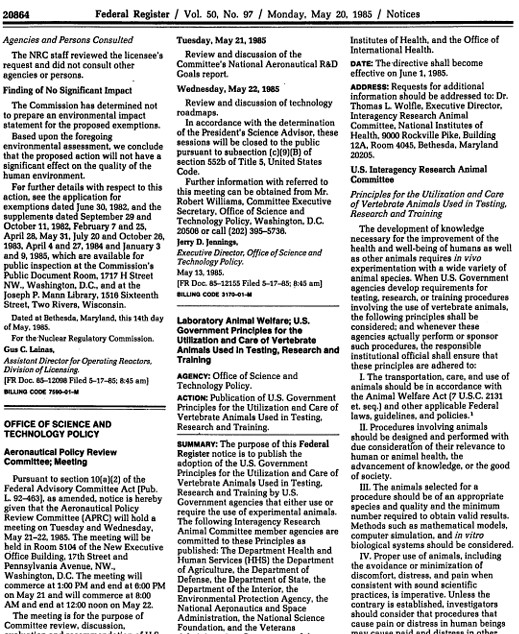
|
The U.S. Government Principles were published in the U.S. Federal Register on May 20, 1985, and are included in the PHS Policy. They provide the ethical framework for currently accepted approaches in the care and housing of research animals. Whenever U.S. Government agencies develop requirements for testing, research, or training procedures involving the use of vertebrate animals, these principles are considered. Scroll down to the blue title banner to view the HTML version of the U.S. Government Principles. The full text can also be found in the PHS Policy and the Federal Register (50 Fed. Reg. 20864). PDF External Site |
U.S. Government Principles for the Utilization and Care of Vertebrate Animals Used in Testing, Research, and Training
The development of knowledge necessary for the improvement of the health and well-being of humans as well as other animals requires in vivo experimentation with a wide variety of animal species. Whenever U.S. Government agencies develop requirements for testing, research, or training procedures involving the use of vertebrate animals, the following principles shall be considered; and whenever these agencies actually perform or sponsor such procedures, the responsible Institutional Official shall ensure that these principles are adhered to:
I. The transportation, care, and use of animals should be in accordance with the Animal Welfare Act (7 U.S.C. 2131 et seq.) and other applicable Federal laws, guidelines, and policies.*
II. Procedures involving animals should be designed and performed with due consideration of their relevance to human or animal health, the advancement of knowledge, or the good of society.
III. The animals selected for a procedure should be of an appropriate species and quality and the minimum number required to obtain valid results. Methods such as mathematical models, computer simulation, and in vitro biological systems should be considered.
IV. Proper use of animals, including the avoidance or minimization of discomfort, distress, and pain when consistent with sound scientific practices, is imperative. Unless the contrary is established, investigators should consider that procedures that cause pain or distress in human beings may cause pain or distress in other animals.
V. Procedures with animals that may cause more than momentary or slight pain or distress should be performed with appropriate sedation, analgesia, or anesthesia. Surgical or other painful procedures should not be performed on unanesthetized animals paralyzed by chemical agents.
VI. Animals that would otherwise suffer severe or chronic pain or distress that cannot be relieved should be painlessly killed at the end of the procedure or, if appropriate, during the procedure.
VII. The living conditions of animals should be appropriate for their species and contribute to their health and comfort. Normally, the housing, feeding, and care of all animals used for biomedical purposes must be directed by a veterinarian or other scientist trained and experienced in the proper care, handling, and use of the species being maintained or studied. In any case, veterinary care shall be provided as indicated.
VIII. Investigators and other personnel shall be appropriately qualified and experienced for conducting procedures on living animals. Adequate arrangements shall be made for their in-service training, including the proper and humane care and use of laboratory animals.
IX. Where exceptions are required in relation to the provisions of these Principles, the decisions should not rest with the investigators directly concerned but should be made, with due regard to Principle II, by an appropriate review group such as an institutional animal care and use committee. Such exceptions should not be made solely for the purposes of teaching or demonstration.**
*For guidance throughout these Principles, the reader is referred to the Guide for the Care and Use of Laboratory Animals prepared by the Institute of Laboratory Animal Resources, National Academy of Sciences.
**Published in the Federal Register, May 20, 1985, Vol. 50, No. 97, by the Office of Science and Technology Policy [FR Doc. 85-12059].







